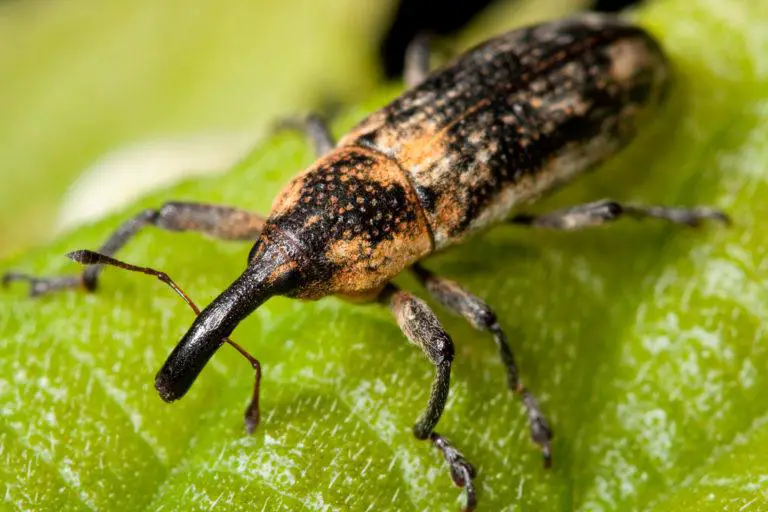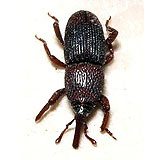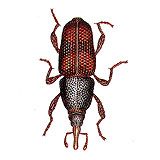
I am pleased and honored to be the one to tell you that yes, you have eaten weevils. I know it’s a disgusting thought (or an invigorating one, no judgement), but there’s really nothing to be done about it. Most people are never even aware that it has happened. It might have simply been their eggs. It could, however, have been little bits of exoskeleton, maybe a leg or two, or possibly even the entire nasty weevil . . . or at least its larvae. With something as common as weevils, it’s pretty much unavoidable. They can be found in nearly any prepackaged food you buy that contains any sort of grain. I’m talkin’ cookies, crackers, biscuits, cake mixes, pastas, breakfast cereals, anything. This is due to the fact that weevils lay their eggs in, you guessed it, grains.
The two most common types of pantry weevils are the granary weevil (Sitophilus granarius) and the rice weevil (Sitophilus oryzae). They are often referred to as snout weevils. These little pantry pests are actually beetles; very small beetles that rarely get any larger than ¼ of an inch. Female weevils use their little snouts to drill holes in the casings of grains, such as wheat, oats, rye, rice, corn, barley, and various seeds and beans. Once the hole is drilled, she deposits an egg and seals the hole back up with a gelatinous glue-like substance that she creates all by her little self. The egg hatches after a few days, and the larvae uses its surroundings as a lunch box for about the next month. For this reason, it can be difficult to detect an infestation. Not only is it slow to start but the larvae are in hiding. Once grain weevils (a.k.a. flour weevils) or rice weevils present themselves, you’ve got a problem. A single female can lay up to 400 eggs, which means up to 400 more hungry bugs lookin’ for a snack. If you’ve experienced something like this, you’ll need to know how to control and get rid of weevils.
Weevil Identification

Rice Weevil
- 1/8- to 3/16-inch long
- Dull reddish brownRound pits on thorax
- Four light spots on carapace
- Able to fly
- Found more commonly in warmer states

Granary Weevil
- 1/8- to 3/16-inch long
- Shiny reddish brown
- Elongated pits on thorax
- Can’t fly
- Found more commonly in cooler states
Best Methods of Weevil Control
Remove contaminated food products.
Sounds like a no-brainer, but this might be the single most important step in getting rid of weevils. Look through your ENTIRE pantry and every single cupboard for any food products that might be contaminated. If you find something that you aren’t sure of, pitch it. There’s no point in risking reinfestation. It could very well cost you more money in the long run. Once you have it all gathered up, take it outside to the trash immediately and move the can as far away from your house as possible.
Pull a Cinderella.
Conduct the most thorough cleaning of your pantry and cupboards that you have ever done. Start by taking absolutely everything off the shelves and vacuuming them. Make sure to get all the cracks where flour or other food bits might be hiding. If you have contact paper lining the shelves, remove it (you can put new stuff on later). Use a rag and some hot sudsy water to do the rest of the cleaning.
Kill weevils with cold.
To avoid future problems with weevils, it is advisable to freeze your food. You can do this to flour, oats, cookies, corn meal, grits, whatever. If you have the space in your freezer, you should just keep the stuff in there full time. If you have a small freezer and can’t afford the space, set the freezer as cold as it gets and leave the food in there for at least four days. That will kill any eggs, larvae, or weevils. Also, that’s an added 4 days of shelf life!
Kill weevils with heat.
If you don’t feel like freezing everything, a little heat exposure will accomplish the same thing. Spread your food or seeds thinly on a baking sheet, preheat the oven to 120°F, and leave it in there for 1 hour. If you’re impatient, you can do 130°F for ½ hour. If you want to use the microwave, spread the stuff on a glass dish or plate, and run it for 5 minutes. Keep in mind that if you are heating seeds for gardening, the heat may destroy the seed’s chances for germination. Also, don’t heat fine-grained things, like flour, in case of combustion.
Further weevil prevention.
Start by cleaning the cupboards and pantry regularly. If you spill something, clean it up immediately and thoroughly. In the pantry and cupboards, you may want to consider sealing any shelving cracks with caulk to keep food from getting trapped down there in the future. Buy your goods in smaller amounts that you can use quickly. Rotate your stock and don’t mix new food with old. Finally, store all of your perishables in tight-lidded glass, tin, steel, or plastic containers. If you have limited cupboard space, Rubbermaid modular containers (sold at Amazon) may be a good plan.
Control Weevils with Pyrethrins
With as common a pantry pest as weevils are, you would think that there would be quite a number of pesticides that target them directly. Unfortunately, this is far from the case. The reason is simple: weevils live and breed in your food. Since you would like to eat that food, contaminating it with insecticides probably isn’t the best idea. For this reason, you should probably just stick with pyrethrins. There are quite a few different pyrethrin sprays and aerosols available that are sold to be used indoors and in food handling areas. You should still avoid spraying the food directly. Once your pantry and cupboards are completely empty, spray them down. I would recommend you leave the cupboards empty and open for at least a few hours before filling them back up. Look for products such as CB-80 Extra, Riptide Waterbased Pyrethrin ULV, and Konk Too.
Best Natural Weevil Control Methods
Bay leaves.
Bay leaves are a natural weevil deterrent. After freezing or heating your grains, drop a bay leaf or two into the storage container on top of the food product you want to be protected. You may also wish to randomly scatter a few leaves around the cupboard or pantry. Amazon sells a bundle of ’em here.
Cloves.
Cloves are another natural deterrent for weevils. Treat your grains with cloves the same way you would with bay leaves. After treating your food with hot or cold, drop a clove on top of it before storing. Scatter a couple around the cupboards and pantry too. Hell, go crazy and try a couple of each.
Matchbooks.
Sounds odd, I know, but I read this suggestion in a number of places. Take a plain old matchbook, open it up, and set it in with your grains or pastas. Apparently the sulfur smell from the matches acts as a weevil deterrent.